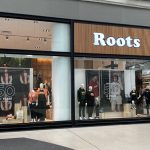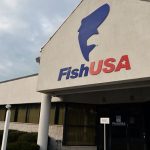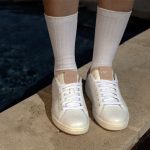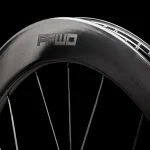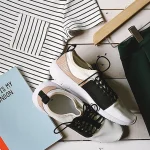Navigating a challenging run specialty channel much more adeptly than their lucky, hometown Seahawks are managing their playoff run, Brooks Running posted a 15 percent increase in revenue growth in 2014, reaching a half a billion dollars in annual sales.
“We’re really pleased with 2014,” said Jim Weber, CEO, who guaranteed a Seattle Super Bowl win, at a breakfast meeting at the Outdoor Retailer show. The year also saw the company move into new headquarters and mark its 100th year anniversary.
Weber noted that since he joined Brooks in 2001 and embarked on a solely run-focused strategy, revenues have grown at a 15 percent compounded rate over the last 13 years “and it’s accelerated over the last 5 years, especially in the U.S.”
The acceleration came after Brooks five years ago established its 2020 vision to become the next $1 billion athletic brand and fully committed to its Run Happy positioning.
Dan Sheridan, general manager, North America, said 2014 “started out a little crazy” with the polar vortex’s arrival causing retailers to “hibernate a little bit.” But warmer weather followed and Brooks churned out 13 percent growth in footwear in the U.S. last year.
Franchised models led the way with over 20 percent growth. According to POS data, Brooks grew its No. 1 market share position at specialty running account stores (SRAs) nationwide for the rolling year (December 2013 through November 2014) to 31 percent in performance running footwear retail dollar share. Said Sheridan, “We saw great growth in market share across channels this year.”
The Ghost 6 held the No. 1 position in the growing neutral footwear category at SRA while the Adrenaline GTS remained the top choice in stability for the sixth year in a row and “continued go grow really nicely.” Brooks also saw “incredible double growth in other core styles like Glycerin and Ravenna.”
Like some other brands, Brooks saw a shift away from its minimalist offerings represented by the Pure Project collection. Sheridan said the company believes Pure is “is rightsizing itself and it will be a core biz for us.”
In other regions, Brooks saw a 32 percent jump in EMEA (Europe, the Middle East and Africa) on a local currency basis. In January 2014, Brooks relocated its EMEA headquarters to Amsterdam and placed David Bohan, formerly president and COO, as EMEA president to lead expansion there.
A direct organization was also formed in Canada, replacing a distributor of 35 years. Based in Toronto, the Canadian office has 14 employees delivered 37 percent growth in 2014. Sheridan said Brooks is “at the starting line in Canada” in terms of brand awareness.
Among product launches, Transcend, the brand’s first maximalist offering that launched in February 2014, “brought a lot of excitement in the specialty channel” and “we see great, great momentum with that style and in that category.”
Brooks also brought back some heritage styles with the Chariot, Vanguard and Vantage. A limited launch at some sneaker boutiques in the U.S. was “pretty successful for us in a small way,” and the collection is now being offered to run specialty shops. Noting that the heritage line’s popularity at Brooks’ headquarters, Sheridan said, ”It’s a fun way to bring energy to our brand.”
Pure apparel also launched to represent the brand’s “first toe in the water on our performance lifestyle business,” said Sheridan.
Indeed, much of the presentation previewed the overhaul of Brooks apparel collection over the last two years under the direction of Anne Cavassa, VP global apparel. The collection arrives Fall 2015.
In developing the collection, one goal was for apparel to be “on par with our footwear from a quality perspective and a runability perspective,” according to Cavassa. Her team has been “hyper, hyper focused on the runner and what their needs are” and the collection doesn’t compromise on performance features. At the same time, the collection is designed to meet the runners needs “on and off the run” from a style standpoint.
She added, “From hanging out at a social event or wanting to go to a café, runners want to look comfortable. They don’t want to look like competitive runners.”
Brooks was also seeking to create a “signature aesthetic” to make the line stand out amid the “sea of sameness” on apparel floors. Cavassa noted that runners often have to look at the label to know what brand an apparel item is.
The design inspiration came from simplicity, minimalism and functionality found in Scandinavian culture. For the most part, about 98 percent of Brooks apparel collection will be new with the popular LSD and Sherpa styles continuing. It features about 40 percent fewer styles than before.
The collection features proprietary DriLayer moisture-wicking fabrics, the first time Brooks has had a fabrication platform across an entire collection. It also marks the first time Brooks will use wool in parts of the collection. Beyond details such as moisture-management, waterproof, warmth and feel depending on the item, subtler materials such as waterproof pockets, and earphone-friendly features are geared for the runner.
For the first time, Brooks has also standardized its fit blocks to ensure consistent sizing across both genders. Said Cavassa, “If we can deliver on the look, the feel and the fit, we know we’ll be winning with runners.”
Cavassa also discussed Brooks sister brand, Moving Comfort, which phased out its apparel collection last year to focus solely on sports bras. The brand has a 76 percent share in the SRA. Its share is about 9 percent at national chains, which is strong given Moving Comfort has an overall brand awareness of just under 3 percent.
Cavassa said a survey of 1,000 women found that 89 percent of Moving Comfort wearers identify say Moving Comfort as their favorite sports brand. So a major effort will be to encourage trial and reach “women who never experienced the right sports bra,” said Cavassa. She noted that bras are “the most loyalty driven silhouette.” For 2015, Moving Comfort is introducing the Uprise and Uplift, two lightweight and versatile crossback styles that provide support and shape in a fashion-forward silhouette.
Brooks admits to the challenges in running apparel for itself and SRA. Beyond Nike, Under Armour and Lululemon in athletic, department stores, Target, Gap and others are all going after the athleisure opportunity.
Weber said Brooks “first benchmark” in apparel is to build a $100 million business to support investments in supply chain and compete more effectively. Currently, Brooks will only say apparel represents between 10 to 15 percent of revenues. The aim is to become the “uniform of the run” and the top resource in SRA, where Nike dominates apparel.
Sheridan said some of the apparel push involves convincing stores they “need to be different in the brands that you carry” to further differentiate. Sheridan said of Brooks, “It’s a brand you can’t find everywhere else.”
But it also involves how product flows into stores, SKU management, and particularly how product is shown. Brooks is actively working with stores on visual presentation, staff training, and marketing around the apparel opportunity.
Brooks also spent considerable time detailing the overall brand’s momentum, including being awarded in December the Vendor of the Year award from the IRRA (Independent Running Retailers Association), being nominated for Vendor of the Year for the third out of the last five years by REI, and numerous product awards from consumer magazines such as Runner’s World. In Sports Marketing Surveys Running Specialty Store Sales Survey of 75 independent retailers last year, Brooks was voted number one in 14 of 19 categories, including on-time delivery, customer service, sales reps and marketing energy.
Brooks also expects to continue to benefit from the steady growth in running participation since the mid-nineties not only with marathons but also lately from fun funs, mud runs and other alternative races. Weber said while track & field and cross-country are the “heart and soul” of run, the activity “goes way beyond competitive sport” to areas of inspiration. Said Weber, “People are investing in their own health and wellness and ultimately, their happiness.”
With the brand’s unique “Run Happy’ position, Brooks is “completely dialed into that.” Indeed, his team often refers to that positioning as Run Happy messaging as “our biggest single completive advantage” because “there’s a lot of players in this industry that have more of everything that we have.”
Brooks team also touched on a rare challenging year faced by the run specialty channel in 2014, which has been blamed on aggressive expansion from the Finish Line’s Run Specialty Group and other regional running shops, the shift away from minimalist offerings and online competition.
Sheridan believes run specialty remains a “very, very healthy channel,” supported by their product knowledge and efforts to engage runners and drive participation. But he said where runners shop has “changed over the years. They’re shopping multichannel.”
As a result, Brooks is having conversations around “around community – what makes these specialty run shops so special” and collaborating on events such as training groups and sports medicine nights that further makes them “different,” according to Sheridan.
Another focus is inventory. Like other channels, Sheridan believes run specialty is finding that showrooming (seeing product in store then buying online) is occurring much less than webrooming (seeing product online then buying in store). The challenge for running shops is having the product seen online in stock. As such, Brooks is starting to have conversations around drop-ship programs and aggregating inventory across the channel to better manage inventory. Said Sheridan, “We know our runners are shopping in multiple channels but we also know the most relevant channel and largest channel is specialty run. So we’re still investing an incredible amount in that space.”
Asked about any possible acquisitions to join Brooks and Moving Comfort under the Berkshire Hathaway umbrella, Weber said the company has “looked at opportunities,” but any candidate would have to have the potential to dominate a category. Said Weber, “There’s a huge difference between creating a brand and building value versus harvesting. And a lot of brands are essentially in harvest mode and that’s a different skillset. That’s not a skillset we’re tying to develop and trying to build.”
He also believes Brooks and Moving Comfort both have a rare opportunity to lead in run, which he called the “the best category of all sports.” He believes both a “still very underdeveloped” with a chance to double its business just in the U.S.
Said Weber, “We’d rather have a very strong dependable brand at our size versus one that’s three times as big like everyone else. So we’re challenging ourselves on opportunities on the acquisition front but usually they’re not as exciting as the ones we already have in our office.”





